- Clone
- A2F10 (See other available formats)
- Regulatory Status
- RUO
- Other Names
- Flk-2, Flt3, Ly-72
- Isotype
- Rat IgG2a, κ
- Ave. Rating
- Submit a Review
- Product Citations
- publications
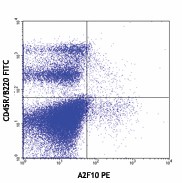
-

Bone marrow cells from C57BL/6 mouse stained with A2F10 PE and CD45R/B220 (RA3-6B2) FITC -

Bone marrow cells from C57BL/6 mouse stained with rat IgG2a, k PE and CD45R/B220 (RA3-6B2) FITC
| Cat # | Size | Price | Quantity Check Availability | Save | ||
|---|---|---|---|---|---|---|
| 135305 | 50 µg | $117 | ||||
| 135306 | 200 µg | $335 | ||||
CD135, also known as Flk-2, Flt3, and Ly-72, is a type III tyrosine kinase receptor. It is expressed on early B lymphoid lineage cells in bone marrow, on primitive myeloid progenitors within the BM CD34+ cell population. Ligation of Flk-2 with Flt3 ligand regulates the growth of hematopoietic stem cells and promotes the survival of primitive hematopoietic progenitor cells with myeloid as well as B lymphoid potential. It was reported that the receptor tyrosine kinase Flt3 is required for dendritic cell development. Combined signaling through interleukin-7 receptors and Flt3 selectively promotes B-cell commitment and differentiation from uncommitted murine bone marrow progenitor cells.
Product DetailsProduct Details
- Verified Reactivity
- Mouse
- Antibody Type
- Monoclonal
- Host Species
- Rat
- Immunogen
- Mouse Flt3 transfected cell line
- Formulation
- Phosphate-buffered solution, pH 7.2, containing 0.09% sodium azide.
- Preparation
- The antibody was purified by affinity chromatography, and conjugated with PE under optimal conditions.
- Concentration
- 0.2 mg/ml
- Storage & Handling
- The antibody solution should be stored undiluted between 2°C and 8°C, and protected from prolonged exposure to light. Do not freeze.
- Application
-
FC - Quality tested
- Recommended Usage
-
Each lot of this antibody is quality control tested by immunofluorescent staining with flow cytometric analysis. For flow cytometric staining, the suggested use of this reagent is ≤ 1.0 µg per 106 cells in 100 µl volume. It is recommended that the reagent be titrated for optimal performance for each application.
- Excitation Laser
-
Blue Laser (488 nm)
Green Laser (532 nm)/Yellow-Green Laser (561 nm)
-
Application References
(PubMed link indicates BioLegend citation) -
- Sergejeva S, et al. 2004. Blood 103:1270.
- Auffray C, et al. 2009. J. Exp. Med. 206:595.
- Chiba H, et al. 2013. Am J Physiol Cell Physiol. 305:693. PubMed
- Product Citations
-
- RRID
-
AB_1877218 (BioLegend Cat. No. 135305)
AB_1877217 (BioLegend Cat. No. 135306)
Antigen Details
- Structure
- A 135-150 kD molecule belonging to the tyrosine kinase receptor family.
- Distribution
-
Expressed on early B lymphoid lineage cells in juvenile and adult bone marrow, primitive myeloid progenitors within the BM CD34+ cell population.
- Function
- Regulate the growth of hematopoietic stem cells and promote the survival of primitive hematopoietic progenitor cells.
- Ligand/Receptor
- Flk-2/FLT3 ligand
- Cell Type
- B cells, Hematopoietic stem and progenitors
- Biology Area
- Immunology
- Molecular Family
- CD Molecules
- Antigen References
-
1. Waskow C, et al.Nat. Immunol. 9:676
2. Veiby OP, et al. 1996. Blood 88(4):1256
3. Veiby OP, et al. 1996. J. Immunol. 157(7):2953
4. Mattews W, et al. 1991. Cell. 65(7):1143
5. Hannum C, et al. 1994. Nature 368(2):643
6. Ogawa M, et al. 1998. Exp Hematol. 26(6):478 - Gene ID
- 14255 View all products for this Gene ID
- UniProt
- View information about CD135 on UniProt.org
Related FAQs
- What type of PE do you use in your conjugates?
- We use R-PE in our conjugates.
Other Formats
View All CD135 Reagents Request Custom Conjugation| Description | Clone | Applications |
|---|---|---|
| PE anti-mouse CD135 | A2F10 | FC |
| Biotin anti-mouse CD135 | A2F10 | FC |
| APC anti-mouse CD135 | A2F10 | FC |
| PE/Cyanine5 anti-mouse CD135 | A2F10 | FC |
| Brilliant Violet 421™ anti-mouse CD135 | A2F10 | FC |
| TotalSeq™-A0098 anti-mouse CD135 | A2F10 | PG |
| TotalSeq™-B0098 anti-mouse CD135 | A2F10 | PG |
| TotalSeq™-C0098 anti-mouse CD135 | A2F10 | PG |
| KIRAVIA Blue 520™ anti-mouse CD135 | A2F10 | FC |
Customers Also Purchased
Compare Data Across All Formats
This data display is provided for general comparisons between formats.
Your actual data may vary due to variations in samples, target cells, instruments and their settings, staining conditions, and other factors.
If you need assistance with selecting the best format contact our expert technical support team.
-
PE anti-mouse CD135
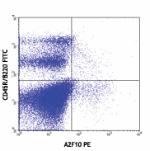
Bone marrow cells from C57BL/6 mouse stained with A2F10 PE a... 
Bone marrow cells from C57BL/6 mouse stained with rat IgG2a,... -
Biotin anti-mouse CD135

C57BL/6 bone marrow cells stained with CD45R/B220 + CD11b AP... -
APC anti-mouse CD135
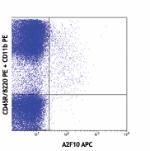
C57BL/6 bone marrow cells stained with A2F10 APC and CD45R/B... 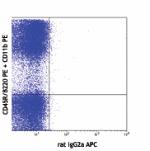
C57BL/6 bone marrow cells stained with rat IgG2a APC isotype... -
PE/Cyanine5 anti-mouse CD135
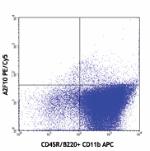
C57BL/6 bone marrow cells stained with A2F10 PE/Cyanine5 and... 
C57BL/6 bone marrow cells stained with rat IgG2a PE/Cyanine5... -
Brilliant Violet 421™ anti-mouse CD135
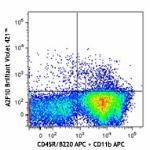
C57 BL/6 bone marrow cells stained with CD45R/B220 APC+ CD11... 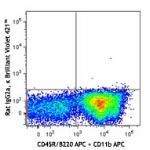
-
TotalSeq™-A0098 anti-mouse CD135
-
TotalSeq™-B0098 anti-mouse CD135
-
TotalSeq™-C0098 anti-mouse CD135
-
KIRAVIA Blue 520™ anti-mouse CD135

C57BL/6 bone marrow cells stained with anti-mouse CD45R/B220...
 Login/Register
Login/Register 










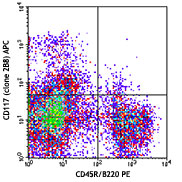
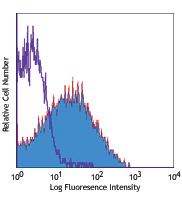
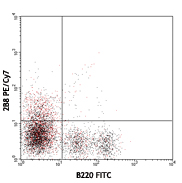
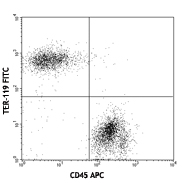



Follow Us